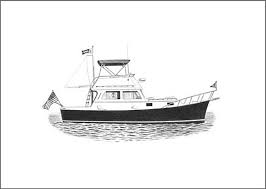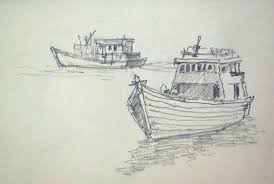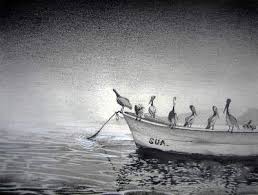Source:Google.com.pk
Pencil Drawings Of Boats Biography
By following these step-by-step instructions, you can use this secret to learn to draw many different kinds of boats. By copying these pictures, you will learn basic drawing skills. You will be able to use those skills to draw other boats ... or even other objects!
Before you start drawing, there are some basic tools you need. Make sure you have a pencil, a pencil sharpener, an eraser, a felt-tip pen, and, of course, the grid paper where you'll make your drawings.
Throughout this article, the sketches start with larger basic shapes. Draw the full shape, even if all of it will not be seen in the final drawing. You can erase the part you don't need later.
Each consecutive step adds more detail until you have the finished drawing. The steps are colored to show exactly what to draw when: The drawings for each new step are shown with red lines, while the lines from previous steps are shown in gray.
After all the steps are drawn, use a felt-tip pen to trace the pencil lines. Go over only the lines you need in the final drawing. After giving the felt-tip ink some time to dry so it won't smear, use an eraser to erase the extra pencil lines.
And there's your completed picture! The next step is learning to color the boat.
Start off by using coloring tools that are familiar to you. For example, if you enjoy coloring with crayons, use them. When you get more comfortable with coloring, you can try other methods like colored pencils, watercolor paints, markers, or even colored chalk. Try different techniques on the drawings to see what looks best.
laude Monet has emerged in the recent literature as a different historical figure from the courageous, penniless and misunderstood revolutionary portrayed in John Rewald's History of Impressionism (1946). In fact, Virginia Spate (The Colour of Time, 1992) had characterized Monet as a self-centered artist, a spendthrift with dandy tendencies rather than a sympathetic or generous person, even to friends of family, and as a perennial manipulator. Although he indeed experienced bad years, especially in the late 1860s and late '70s, it turns out that he was actually rather well-to-do for most of his life.
All in all, it would seem that Monet had a higher standard of living than the average Parisian doctor, and beginning in the 1890s he became downright wealthy. If he had been sometimes short of cash, it was because he liked to live in big houses, eat good food and drink good wine. Later on he was far more affluent, partly because of the high prices his work commanded, partly because - not what you might expect of a misty, nature-loving Impressionist, this - he played the stock exchange.
If Monet talked a lot about money, it was, in the words of the biographer Spate, because he was "obsessed by it, chronically mean but a huge spender, and even when he was very rich, irrationally fearful of losing everything".
However, income aside, it would be misleading to forget how non-conformist Monet was for his times: he fathered his first child out of wedlock, avoided wartime military responsibilities, setup a household (after the death of his first wife) with a married woman and disavowed religion to say nothing of his revolutionary approach to painting which left the 20th century a lasting legacy." (1)








Pencil Drawings Of Boats Biography
By following these step-by-step instructions, you can use this secret to learn to draw many different kinds of boats. By copying these pictures, you will learn basic drawing skills. You will be able to use those skills to draw other boats ... or even other objects!
Before you start drawing, there are some basic tools you need. Make sure you have a pencil, a pencil sharpener, an eraser, a felt-tip pen, and, of course, the grid paper where you'll make your drawings.
Throughout this article, the sketches start with larger basic shapes. Draw the full shape, even if all of it will not be seen in the final drawing. You can erase the part you don't need later.
Each consecutive step adds more detail until you have the finished drawing. The steps are colored to show exactly what to draw when: The drawings for each new step are shown with red lines, while the lines from previous steps are shown in gray.
After all the steps are drawn, use a felt-tip pen to trace the pencil lines. Go over only the lines you need in the final drawing. After giving the felt-tip ink some time to dry so it won't smear, use an eraser to erase the extra pencil lines.
And there's your completed picture! The next step is learning to color the boat.
Start off by using coloring tools that are familiar to you. For example, if you enjoy coloring with crayons, use them. When you get more comfortable with coloring, you can try other methods like colored pencils, watercolor paints, markers, or even colored chalk. Try different techniques on the drawings to see what looks best.
laude Monet has emerged in the recent literature as a different historical figure from the courageous, penniless and misunderstood revolutionary portrayed in John Rewald's History of Impressionism (1946). In fact, Virginia Spate (The Colour of Time, 1992) had characterized Monet as a self-centered artist, a spendthrift with dandy tendencies rather than a sympathetic or generous person, even to friends of family, and as a perennial manipulator. Although he indeed experienced bad years, especially in the late 1860s and late '70s, it turns out that he was actually rather well-to-do for most of his life.
All in all, it would seem that Monet had a higher standard of living than the average Parisian doctor, and beginning in the 1890s he became downright wealthy. If he had been sometimes short of cash, it was because he liked to live in big houses, eat good food and drink good wine. Later on he was far more affluent, partly because of the high prices his work commanded, partly because - not what you might expect of a misty, nature-loving Impressionist, this - he played the stock exchange.
If Monet talked a lot about money, it was, in the words of the biographer Spate, because he was "obsessed by it, chronically mean but a huge spender, and even when he was very rich, irrationally fearful of losing everything".
However, income aside, it would be misleading to forget how non-conformist Monet was for his times: he fathered his first child out of wedlock, avoided wartime military responsibilities, setup a household (after the death of his first wife) with a married woman and disavowed religion to say nothing of his revolutionary approach to painting which left the 20th century a lasting legacy." (1)
Pencil Drawings Of Boats
Pencil Drawings Of Boats
Pencil Drawings Of Boats
Pencil Drawings Of Boats
Pencil Drawings Of Boats
Pencil Drawings Of Boats
Pencil Drawings Of Boats
Pencil Drawings Of Boats
Pencil Drawings Of Boats
How To Draw The Titanic
How To Draw A Boat
No comments:
Post a Comment